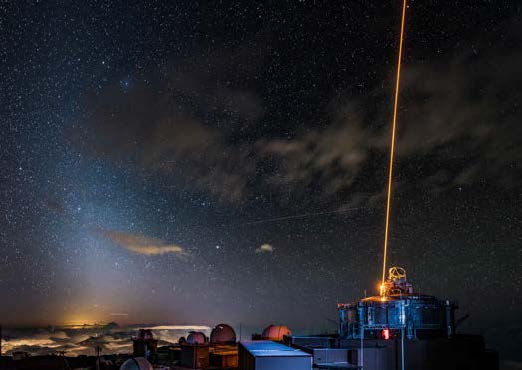AIR FORCE MAUI OPTICAL AND SUPERCOMPUTING (AMOS) SITE
For updates on the ongoing AMOS STAR Environmental Impact Statement (EIS) proposal, please visit www.amosstareis.com.
Freedom to operate and maintain satellites in space is a critical component of our national security. The U.S. Air Force assists in achieving this freedom, in part, by maintaining an awareness of the locations and capabilities of all man-made objects in space. This awareness is called space domain awareness (SDA). The scientists and engineers of the Air Force Research Laboratory (AFRL) advance technologies that improve the nation’s capability to maintain SSA as the number, sizes, locations, and capabilities of man-made objects in space evolve over time.
The AFRL Directed Energy Directorate operates two major telescope sites that are used to advance SSA technologies. One of these sites is located on Kirtland Air Force Base, New Mexico, and the other site is located on Maui, Hawaii. The Maui site is called the Air Force Maui Optical and Supercomputing (AMOS) site.
ABOUT THE AMOS SITE
The AMOS site consists of two facilities that conduct SDA operations and research and development (R&D). The first facility is the Maui Space Surveillance System (MSSS) and the second is the Maui High Performance Computing Center (MHPCC).
Research thrusts at the AMOS site include satellite detection and identification, atmospheric compensation and resolved imaging, astrodynamics and orbital metrics, sensor development, laser propagation through the Earth’s atmosphere, database cataloging of satellite images, and high-performance computer modeling and simulation. In addition to its use as an R&D facility, AMOS has been called upon to help identify and/or track spacecraft payloads and communication satellites.
The unique focus on research and development as well as operations provides a rapid development cycle from concept to operational implementation. Researchers are exposed to the actual needs of the operational space community and are able to provide innovative answers in an operationally relevant time frame.

Sodium guidestar for sensing atmosphere at the Maui Space Surveillance System facility atop Haleakala. Photo credit: Robert Q. Fugate
Products include satellite imagery, space object signature data, space object positional data, advanced image post processing, data exploitation tools and techniques, laser propagation through the Earth’s atmosphere, and high performance computer modeling and simulation. Most recently AFRL installed a sodium guidestar, which has the ability to propagate light into the sodium layer of the atmosphere and create an artificial star.
MAUI SPACE SURVEILLANCE SYSTEM (MSSS)
As a state-of-the-art electro-optical facility, the MSSS combines research and development with an operational mission; the only one of its kind in the world. The location at 10,000 feet above sea level and Maui’s stable climate with minimal scattered surface light provide excellent viewing conditions most days of the year. MSSS uses its visible and infrared sensors, adaptive optics, and telescopes to collect imaging and signature data on near-Earth and deep-space objects. AFRL scientists and engineers analyze this data and disseminate imaging and signature products in support of SDA current needs.

Processed Imagery of Hubble Space Telescope
MAUI HIGH PERFORMANCE COMPUTING CENTER (MHPCC)
The MHPCC is the “Vanguard Center of DoD High Performance Computing (HPC),” with a mission to evaluate and optimize early production HPC technology and provide breakthrough software solutions in support of DoD research, development, test, and evaluation (RDT&E) programs. Located in the Maui Research and Technology Park with high-bandwidth connectivity to MSSS, other Hawaiian islands, and the continental U.S., MHPCC investigates emerging HPC technology, provides HPC-backed solutions for high-priority defense programs, and lowers barriers to high-productivity computing for the DoD RDT&E community.
OUTREACH
AMOS partners with a number of organizations including the University of Hawaii’s Institute for Astronomy, University of Hawaii Maui College, the Air Force Office of Scientific Research, Maui Economic Development Board, and local high-tech organizations. In addition to the goodwill, AMOS outreach encourages educational paths through its science, technology, engineering, and math (STEM) program that is designed to introduce students to STEM-oriented careers and promote employment at AMOS and local hightech organizations.
CULTURE
Since 1980, numerous studies have been undertaken at Haleakala Observatories in the interest of environmental, cultural, historic, and economic resources, as well as to mitigate the potential impacts to those resources. AMOS observes environmental conservation programs that include protection of the silversword plant and the Hawaiian Nene, or Goose, which are on the Federal List of Endangered Species and can be found atop Haleakala.

The 3.6-meter, 75-ton Advanced Electro-Optical System (AEOS) telescope shown above is the largest optical telescope in the Department of Defense. In addition the Maui Space Surveillance System facility houses several other telescopes ranging from 0.4 to 1.6-meters. Photo credit: AFRL
